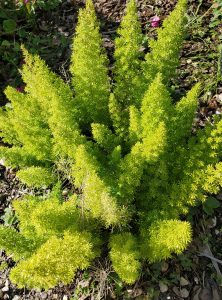While you normally can’t successfully grow edible asparagus in Southwest Florida due to our overly warm and wet climate, you can grow a number of ornamental types that make great container plants for patios, indoors as houseplants, or in some cases, as a groundcover. These asparagus are foliage gems worth growing for their lush, velvety growth and eye appeal.
Ornamental asparagus are often labeled as” ferns” due to their sprays of fern-like foliage. These plants are not true ferns, but do have fine, leaf-like branchlets called cladophylls which give them their unique ornamental fern-like quality. Located on their woody, wiry stems, the hardly noticeable true leaves are scale-like in appearance. Ornamental asparagus also have small spines on their stems so watch how you handle them. Small white or pink flowers are followed by red or orange inedible fruit. Birds enjoy the fruit and tend to spread the seeds around.

Probably the most common ornamental asparagus available is Asparagus aethiopicus, also known as Sprenger’s Asparagus Fern – you can find it in nearly every garden center. A friendly warning – Sprenger’s Asparagus Fern is considered a Category I invasive plant by Florida Exotic Pest Plant Council. This ornamental asparagus plant has escaped cultivation and is in natural areas in Florida where it is displacing native species. Both seeds and tubers help propagate this plant in places it should not be found. I have seen it naturalized in multiple places in Charlotte County. While not really recommended, if you cultivate this asparagus plant, maintain it in containers only (not in the ground) and under your watchful eye – do not allow it to escape!

There are other “tamer” ornamental asparagus species to pick from. ‘Myers’ Asparagus Fern, commonly called the foxtail fern, is a cultivar of A. densiflorus named after its similarity to a fluffy, plume-like tail. This asparagus is a beautiful perennial plant suitable for containers, hanging baskets, as a houseplant, or as a groundcover. The foxtail asparagus can be easily divided and propagated from time to time if it outgrows its space. While foxtail asparagus is nice, perhaps my favorite ornamental asparagus is the one called Ming or Asparagus retrofractus. The full, deep green cladophylls remind you of miniature pine trees. The leaf-like cladophylls almost appear as mini pompoms which bring a special attractiveness to this less common plant. A final type of ornamental asparagus that you may find in garden centers as a houseplant is the Asparagus setaceus, commonly known as Lace Fern or Climbing Asparagus. The asparagus has very fine and lacey cladophylls on vine-like stems. I would keep this one in a container as it is likely to get out of control when planted in the landscape. There are a few cultivars available which have dwarf forms or more upright growth habits. All of these ornamental asparagus need to be used with caution to prevent escape.
Grow your ornamental asparagus in full sun to part shade in a well-drained soil for best results. They are fairly drought tolerant so do not overwater. Besides being featured as an attractive foliage plant, many ornamental asparagus are also used as cut foliage in floral arrangements, boutonnieres, and corsages.
Ornamental asparagus are elegant, easy-to-grow plants. Just keep them under your control and don’t let them accidentally escape! For more information on all types of plants suitable for our area, or to ask a question, you can also call the Master Gardener Volunteer Helpdesk on Mondays, Wednesdays, and Fridays from 1 to 4 pm at 764-4340 for gardening help and insight into their role as an Extension volunteer. Ralph E. Mitchell is the Director/Horticulture Agent for UF/IFAS Extension Charlotte County. He can be reached at 941-764-4344 or ralph.mitchell@charlottecountyfl.gov. Connect with us on social media. Like us on Facebook @CharlotteCountyExtension and follow us on Instagram @ifascharco.
Resources:
Florida Exotic Pest Plant Council ’s 2019 List of Invasive Plant Species – https://bugwoodcloud.org/CDN/fleppc/plantlists/2019/2019_Plant_List_ABSOLUTE_FINAL.pdf
Mueller, C. W. (2008) Asparagus Ferns (Asparagus species). Texas AgriLife Extension Service Texas A&M University, College Station, Texas.
Asparagus setaceus (2023) https://en.wikipedia.org/wiki/Asparagus_setaceus
Gilman, E. F., Klein R. W., & Hansen, G. (2023) ASPARAGUS DENSIFLORUS ‘MYERS’ MYERS ASPARAGUS FERN. The University of Florida Extension Service, IFAS.
Gilman, E. F. , Klein R. W., & Hansen, G. (2022) Asparagus densiflorus ‘Sprengeri’ Sprengeri Asparagus Fern. The University of Florida Extension Service, IFAS.
Gil, D. (2016) Consider growing asparagus ferns. LSUAgCenter.com
UF/IFAS Assessment of Non-Native Plants in Florida’s Natural Areas. (2023). The University of Florida Extension Service, IFAS.
 0
0
